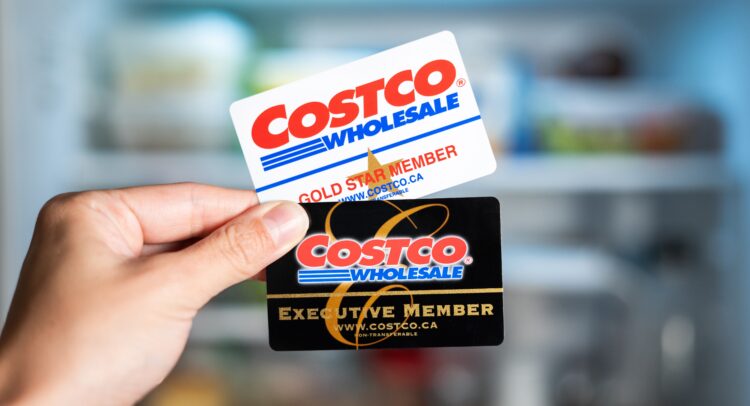Costco (NASDAQ:COST), a big box retailer, is a rare example outside the tech space of a business with a recurring revenue model through subscriptions. Costco stays profitable even in tough economic times with a low-cost, high-volume approach. This is why I’m bullish on Costco.
However, Costco’s unique business model comes with a high price tag, which is apparent when looking at the company’s valuation multiples.
In this article, I’ll explain why Costco stands out, its current position, and its attractive investment thesis.
Why Costco Stands Out
Costco’s business model revolves around offering strategically attractive prices exclusively to members, giving it a strong position in the retail sector.
At first glance, investors might not be too excited about Costco’s 3.8% operating margin, as reported in Q3, and modest growth in operating profits over the past year of about 7.5%. However, the real magic lies in Costco’s business model: recurring subscription revenue through membership fees. Although these fees represent less than 2% of the company’s total revenues, they contribute to nearly 90% of the operating income due to their assumed full profit margins.
Costco boasts around 74.5 million active members and an impressive 90.5% renewal rate globally. This speaks volumes about the company’s effective strategy. By offering products at rock-bottom prices (sometimes with minimal or even negative margins), Costco attracts new members and generates significant operating income from membership fees. This approach builds something invaluable in retail: customer loyalty.
Thanks to its extremely loyal customer base, Costco operates a business that is resistant to economic fluctuations. Even as U.S. retail sales remained flat in April, growing only 0.1% year-over-year, and e-commerce continues to gain market share, Costco managed to increase its sales by 6.4%. This deviation from the general retail trend highlights the loyalty Costco has cultivated, making it a go-to destination for wholesale purchases.
Where Costco Stands Now
Costco stock is on a strong upward trend, rising about 64% over the past twelve months, backed by resilient earnings beats since March 2023.

In Q3, ending in May, Costco saw comparable sales grow by 6.2% year-over-year, compared to 4.1% over the first three quarters of 2023. Regarding net sales, Costco reported $57.3 billion, marking a 9% annual increase. With the company reporting a net income margin of just 2.9%, the bottom line came in at a modest $1.68 billion in net income. But this is all in line with the company’s business model.
The most important metric for analyzing Costco’s profitability is its recurring subscription growth. Throughout 2023, membership income was reported at $4.58 billion (assuming full margins) and rewards at $2.57 billion, contributing nearly 88% of the operating income of $8.14 billion reported for the year.
In Q3, Costco memberships increased by 7.8% to 74.5 million. Notably, 34.5 million of these are executive members. They pay $120 annually for membership, receive a 2% rebate on their purchases, and make up 46% of paid members and almost 73.1% of the company’s sales.
As long as Costco’s membership fees continue to grow, the company’s bottom line should remain strong, likely pleasing shareholders.
Valuation Suggests Little Risk Tolerance
It’s hard to argue that Costco’s valuation multiples don’t seem stretched. The company trades at a P/E of 53x, with a bottom-line growth outlook of just 9% CAGR over the next 3 to 5 years, COST has a PEG ratio of 5.9x, more than double the average for other retailers.
I believe the main reason behind this super-premium valuation is Costco’s unique recurring revenue model through memberships, a rarity outside the tech world. Moreover, the company has nailed the challenging strategy of low margins and high volumes. This strategy involves maintaining a complex and long-standing relationship with suppliers and logistics to ensure profitability.
Additionally, Costco’s current position creates significant barriers to entry for competitors, making it tough to compete with a company that operates on a 3% margin.
While this justifies a premium valuation, trading at such a high premium is also a significant risk. Any slowdown in the growth of membership fees could pressure this multiple, potentially leading to a short-term selloff in Costco’s stock.
On the other hand, if we look at the last five years, COST’s low correlation with the broad index, with a beta of 0.77, suggests a cyclical and low-volatility profile. In my opinion, this low beta helps ease investors’ worries that are in it for the long haul with COST.
Is COST A Buy, According to Wall Street Analysts?
Wall Street analysts are very bullish on COST stock, with the consensus rating pointing to a Strong Buy. Out of the 25 analysts covering the stock, 19 have a Buy recommendation, while the rest are Neutral.
However, the average price target of $862 suggests virtually no upside potential.

Among the analysts, Tigress Financial’s Ivan Feinseth, a five-star analyst according to Tipranks ratings, stands out with the most bullish thesis. He predicts COST will reach $975 per share, citing the company’s strong revenue momentum, ongoing store growth, and international expansion.
Conclusion
COST is counter-cyclical and resilient to tough economic times. The company stays profitable thanks to its extremely loyal customer base and a business model built on recurring revenues from membership fees and strategic pricing.
Costco is arguably the best at executing a low-cost, high-volume strategy, solidifying its stable and resilient market position. This is why COST trades at a super-premium valuation. Given its track record of consistent, above-average returns, I believe the best COST approach is to buy and hold it for the long term.
















